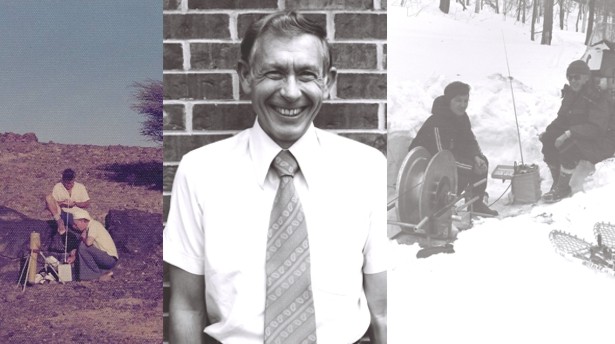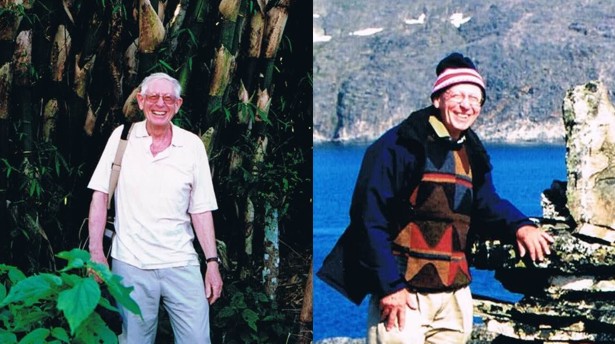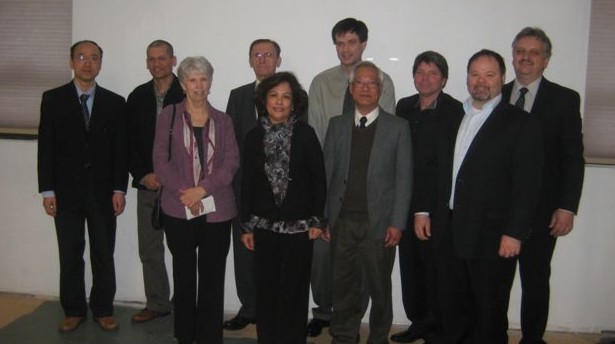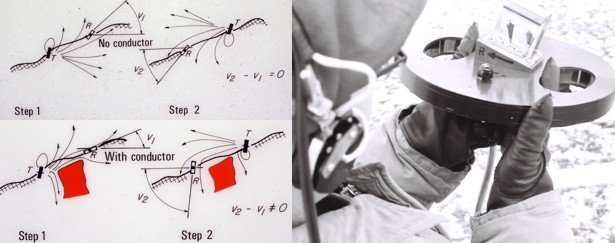— A bridge to the future / Un pont vers le futur |
|
KEGS Homepage 
|
 Geophysical Pioneers | |
|
James Duncan Crone 
(L) Duncan at Al Dariz in Oman in Early 1970s. (C) Duncan, 1985. (R) Duncan and Peter Lenz
with the Prototype Borehole Pulse EM System. James Duncan Crone, pioneering Canadian mining geophysicist, explorationist and entrepreneur, passed away on Friday March 4, 2011, in Mississauga at the age of 81. Duncan, known and recognized in the mining and exploration community around the globe, was a very innovative, practical-minded geophysicist who made numerous important contributions to the advancement of mining geophysics and to mineral exploration discoveries during his long career. Duncan was born in Toronto on August 7, 1929, the oldest of three children.. He attended the University of Toronto, Victoria College, graduating in 1951 with a BASc degree in Mathematics and Physics. Following graduation, he joined the remarkable group of innovative geophysicists working for Newmont in Jerome, Arizona under the legendary Dr. Arthur Brant, which included Harry Seigel and Len Collett (sadly departed only days after Duncan). Here, the practical application of Induced Polarization to mineral exploration was born. Later, with co-operation from Newmont, Duncan would use what he learned in Jerome to build practical I.P. and EM instrumentation which were simple to operate and extremely reliable. In the early 1950’s Duncan returned to Canada and joined Radar Exploration where he was involved with magnetic, gravity, and vertical loop EM surveys following up early airborne EM surveys for massive sulphide deposits. One of Duncan’s achievements during this time was to successfully apply gravity surveys to distinguish graphite from massive sulphides in the Bathurst mining camp. In recognition of his abilities and the growing importance of geophysics, Duncan was asked to set up a geophysics department at Noranda Mines, serving as Noranda’s first Chief Geophysicist from 1956 until 1962. Duncan’s focus at that time was to develop practical, portable EM systems that could be used to find near-surface massive sulphides. The JEM (shown in the photograph below) and the Shootback EM method were invented and developed, constituting great improvements over other instrumentation available at that time. The Shootback method was an ingenious way to remove the effects of topography on tilt-angle EM surveys, as shown in the diagrams below. A borehole EM system was also developed during this time at Noranda, but borehole geophysics was a difficult concept to sell to skeptical geologists and mining engineers, as Duncan would later discover. In 1962, Duncan founded Crone Geophysics Ltd. where the Shootback EM method was further improved and put into production. Duncan’s innovation and inventiveness led him to produce numerous practical and portable instruments such as the CEM (Horizontal Shootback EM with larger coils than the JEM), the VEM (Vertical Loop EM transmitter hoisted on a mast, with tilt-angle CEM receiver), and the RADEM (VLF receiver). These were sold to a worldwide market. Duncan, always close to the action in mineral exploration, was involved with numerous discoveries while consulting for Amoco and Mattagami Lake Mines among others, many of which were based on his picks of priority targets from airborne surveys, and followed-up with his EM instruments. Crone Geophysics was initially located in a small building in the Six Points area of Toronto, and subsequently moved to a location on Lakeshore Blvd, before moving to a larger combined office/shop building on Wolfedale Rd in 1970 in what was then mostly rural portion of Mississauga. The company and building grew during its 38 years at this location, and the farmer’s fields that once surrounded it are now gone. In the 1970s, as Induced Polarization became more widely used around the world, Duncan also saw the need for a practical, light-weight, easy to operate IP system. This led to the development of a battery-powered IP transmitter and compact receiver which facilitated shallow IP surveys in difficult and remote locations as well as borehole IP surveys. Realizing that there was a growing need to look deeper into the earth, and drawing on early instrumentation and research by Newmont, Duncan began to develop borehole and surface time-domain EM equipment, which he named Pulse EM. The original Crone surface Pulse EM system, developed in 1973, was a small, portable, multi-turn loop and an analog receiver which was used initially in the Sultanate of Oman where, serendipitously, the first field test outlined three massive sulphide orebodies. This was the first commercially available surface time-domain EM system in the world, and it was an immediate success. It was soon being used worldwide. The surface Pulse EM gear continued to evolve enabling deeper penetration with larger loops and more power. (Many years later, during his active retirement, Duncan undertook a visit to Oman and the mining operations at the site of the PEM-aided discoveries.) In 1978, the first commercial Borehole Pulse EM system in the world was produced by Crone Geophysics. The borehole method was initially a very hard sell, but Duncan persevered and after a few successes, such as the discovery of an ore lens at a depth of 950m adjacent to the Corbett Mine near Noranda, Duncan (seen operating an early version in an accompanying photo) managed to convince the skeptics that borehole geophysics was a useful, valuable, practical tool. Today, borehole Pulse EM is an integral part of many exploration programs, and has led to the discovery of many deep massive sulphide orebodies. In 1990, Duncan sold the assets of Crone Geophysics Ltd. to a renamed company, Crone Geophysics & Exploration Ltd. owned by many of his veteran employees, while continuing as president. After retiring in 1993, Duncan continued an active life, undertaking many ambitious trips to various parts of the world. 
Duncan travelling in retirement.
Duncan presented many papers and wrote numerous case histories in his very readable, straightforward style. In 1987 his paper at the MGLS Symposium entitled “Case Histories of Borehole Pulse EM Surveys” won the Best Paper Award. Other awards included the A.O. Dufresne Award from the Canadian Institute of Mining in 1992 “in recognition of his pioneering development and successful application of geophysics to mining exploration over the last forty years”, and the Distinguished Service Award from the Prospectors and Developers Association of Canada in 2001 “for his lifetime of work in geophysics and his many important contributions to the advancement of the science.” Duncan was one of the early members of KEGS and a long-standing member of the SEG. In 2009, Duncan was recognized as a geophysical Pioneer by the Canadian Exploration Geophysical Society and is included in the roster of notable Canadian geophysicists honoured and commemorated by the KEGS Pioneers Scholarship Fund for education in geophysics. Crone Geophysics moved several years ago to its current larger premises at Meadowpine Blvd, and in the process its Wolfedale Rd building was sold to an evangelical church group, a repurposing that Duncan thought was entirely fitting. In an interesting turn of events (which Duncan would have likely appreciated), his memorial service was held at this location, officiated by the minister who had presided over his most recent marriage. Many of the current and past employees of Crone Geophysics, seen in the accompanying photo, together with old friends, colleagues, and family gathered at Duncan’s service to remember and reminisce about interesting events in the past, and to remark on his modesty and loyalty, and to cite his enduring influence on their careers and his legacy of geophysical innovation. The easy-to-operate and highly reliable geophysical instruments for practical geophysical surveys developed by Duncan and his dedicated collaborators provided a great service to the exploration industry, contributing to many discoveries, and are his legacy. He will be remembered by many colleagues, associates and friends who were inspired by his ideas, benefited from his innovations and encouragement, and enjoyed his humour, his down-to-earth nature, his generosity of spirit, creativity and entrepreneurial vision, as various participants at his memorial service recounted. 
Past and Current Employees at Memorial Service held in the former Crone Geophysics office (now a church).
(L to R: Steve Wang, Gavin Caspersz, Linda Dadd, Heinz Grunenberg, Carmelita Rabanillo, Colin Millar, Alex Chan, Ken Nurse, Conrad Dix, Bill Ravenhurst) Duncan is survived by his wife, step-daughter, five children from two prior marriages, as well as fifteen grandchildren and sixteen great-grandchildren. For those who wish to make a donation in Duncan’s honour, the family has suggested the KEGS Pioneers Scholarship Fund (www.kegsfoundation.org) for geophysics education at Canadian universities. 
(L top and bottom) Crone Jem Shootback Method: How Shootback EM Corrects for Topography
and Identifies Conductors. (R) The JEM in Operation. |
||
|
© 2015 |